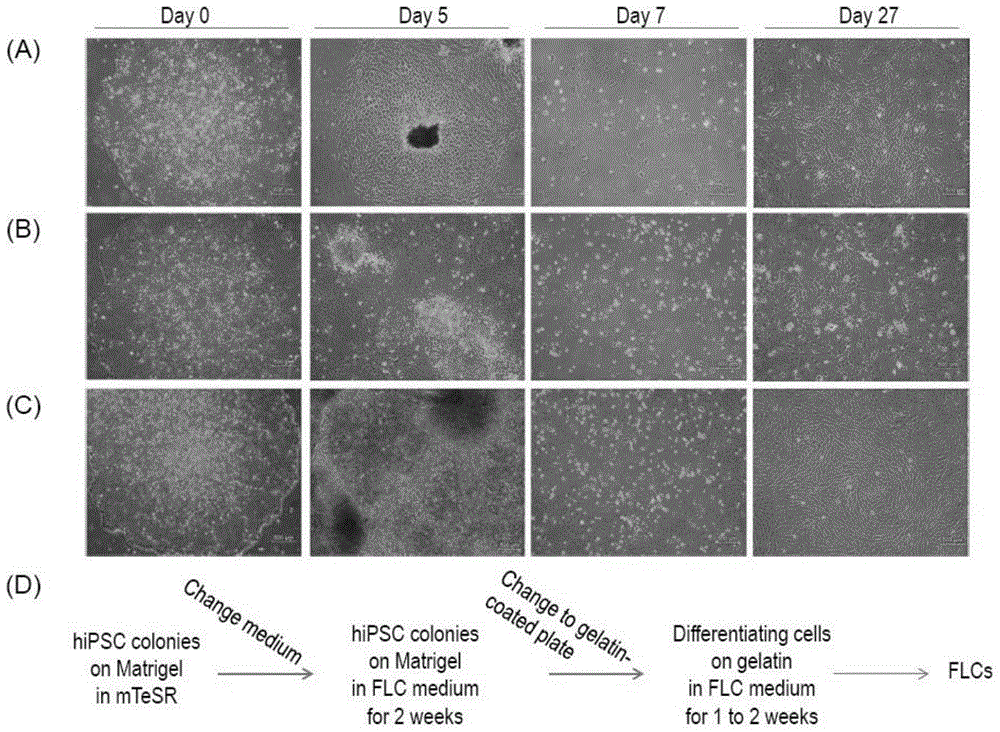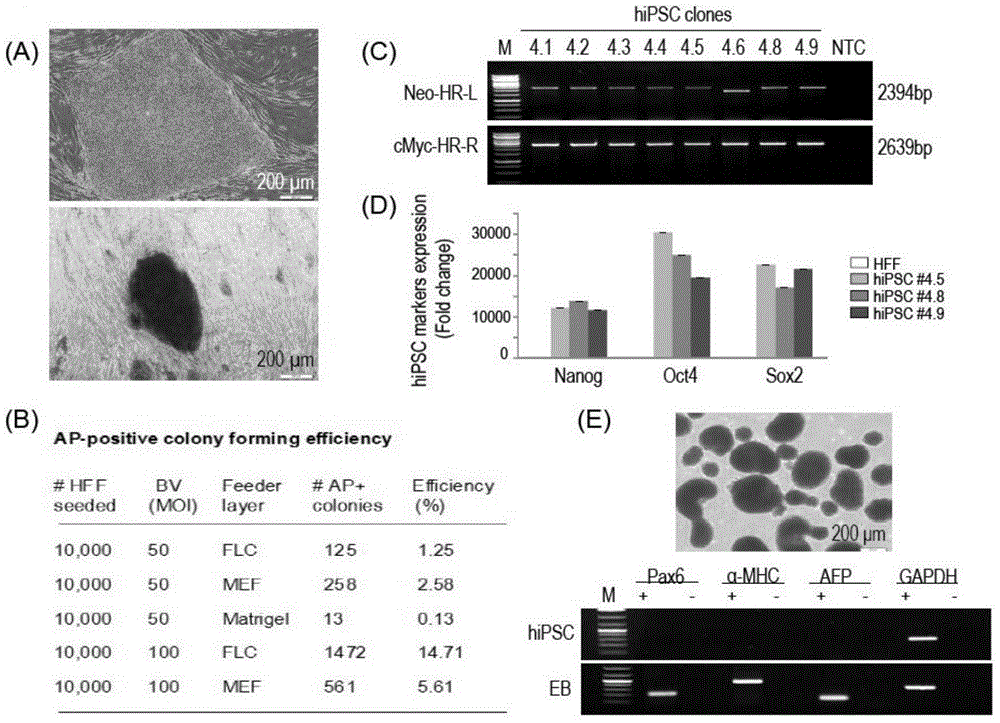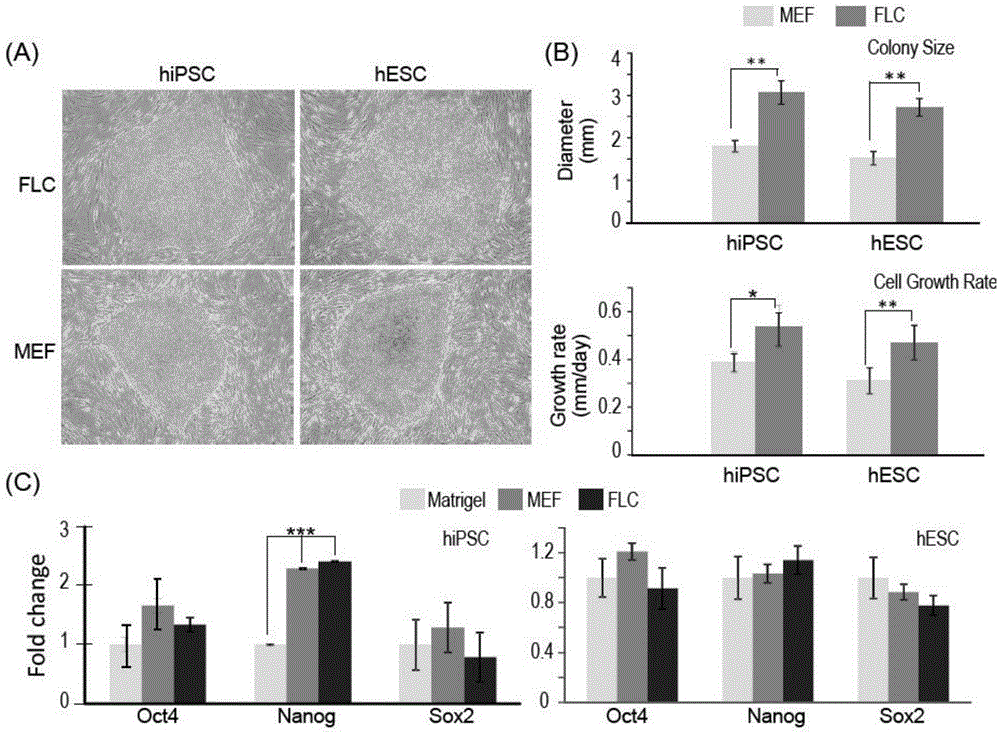Method for developing and cultivating human induced pluripotent stem cells
A technology of pluripotent stem cells and cells, applied in the field of establishing and cultivating human induced pluripotent stem cells, can solve the problems of only 7 generations of culture, short maintenance time, and failure to produce, so as to avoid the risk of spreading animal pathogens and overcome maintenance The effect of short life and guaranteed efficiency
- Summary
- Abstract
- Description
- Claims
- Application Information
AI Technical Summary
Problems solved by technology
Method used
Image
Examples
Embodiment 1
[0029] The preparation of embodiment 1 feeder layer
[0030] The 5.9 cell line of human iPS cells reprogrammed from human foreskin fibroblasts (HFFs) is a prior art, and will not be described in detail here. In the present invention, the 5.9 cell line is used as a source for cultivating FLC. 5.9 The cell line was maintained and cultured on Matrigel for 7 days, and then subcultured after being digested with 1 mg / ml dispase (StemCell Technologies) at 37°C for 5-7 minutes. culture medium 1 (StemCell Technologies) was changed daily. In this experiment, we used three different methods to induce differentiation of the 5.9 cell line into FLC. The induction medium of FLC includes DMEM (Thermo Scientific Company), 10% fetal bovine serum (Thermo Scientific Company) and 0.1 mM non-essential amino acid (NEAA) (Invitrogen Company).
[0031] Method A: Human iPS cells were digested and separated with 0.1 mg / ml dispase at 37°C for 20-30 minutes, and then transferred to ultra-low adsorptio...
Embodiment 2
[0036] Example 2 Culturing Human Induced Pluripotent Stem Cells
[0037] Before using FLC as feeder cells for somatic cell reprogramming, FLC needs to be treated with 10 mg / ml mitomycin C (Millipore) for 3 hours in advance. The somatic cells used for reprogramming are human foreskin fibroblasts (HFFs, Millipore Corporation), and the present invention uses baculovirus-mediated zinc finger nuclease (ZFN) to convert ZFN gene and OSKM gene (Oct4, Sox2, Klf4 and c -Myc) were simultaneously transferred into the cells, so that the OSKM gene was specifically integrated into the AAVS1 site of HFFs. The baculovirus carrying the ZFN gene and the OSKM gene was twice transfected with 1×10 4 HFFs, cell culture medium for FibroGRO TM - LS complete medium (Millipore). The multiplicity of infection (MOI) per cell of baculovirus expressing ZFN gene and OSKM gene was 100 and 50, respectively. After 10 days of drug screening with 200 μg / ml G418, the surviving cells were transferred to the FLC...
Embodiment 3
[0040] Example 3 Effect of human fibroblast-like cells on human induced pluripotent stem cells
[0041] In order to detect the effect of human iPS cell-derived FLC on the growth of human totipotent stem cells, the present invention measured the diameter and daily growth rate of newly generated human iPS cell and human embryonic stem cell H1 cell colonies. These cell populations were cultured on FLC or MEF for at least 5 passages before measurements were started. During the measurement, ten cell colonies were selected to take pictures on the 2nd and 5th days after inoculation, and then the diameters of the cell colonies were measured on the pictures. The cell colony growth rate was calculated according to the following formula: (cell colony diameter on day 5-cell colony diameter on day 2) / 3 days. The expression levels of pluripotent stem cell marker genes in cell populations were analyzed by quantitative qPCR. cultured on Matrigel or The cell colony on 1 was used as a contr...
PUM
 Login to View More
Login to View More Abstract
Description
Claims
Application Information
 Login to View More
Login to View More - R&D
- Intellectual Property
- Life Sciences
- Materials
- Tech Scout
- Unparalleled Data Quality
- Higher Quality Content
- 60% Fewer Hallucinations
Browse by: Latest US Patents, China's latest patents, Technical Efficacy Thesaurus, Application Domain, Technology Topic, Popular Technical Reports.
© 2025 PatSnap. All rights reserved.Legal|Privacy policy|Modern Slavery Act Transparency Statement|Sitemap|About US| Contact US: help@patsnap.com



